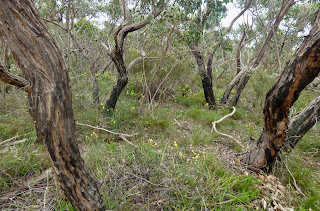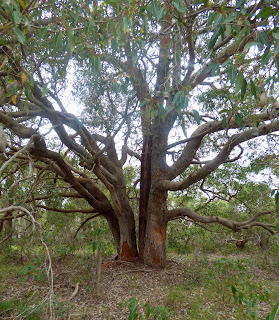A couple of years ago we visited Cox Scrub, a conservation park about 45 minutes north of home. At that time we entered on the eastern side. This time we wanted to try the western entrance. After a couple of sunny days, the weather was back to cool, hence my rather rugged up appearance.
As you can see it's a dry, scrubby forest with a sandy track. We were hoping for some wildflowers and we weren't disappointed. Unfortunately we had no idea what many of these flowers were. My sister, who is an expert in Australian natives, albeit mostly Western Australian ones, was able to identify some of the ones we saw. I tried looking up an online site for local flora but got confused. At least four flowers looked all the same to me; indeed, I swear Lyn's Bossiaea looked exactly like my Dillwynia.
 |
| A calytrix - lovely with its pinks and reds. |
I loved the way the bush had its own host of golden 'daffodils'. They were indeed 'fluttering and dancing in the breeze' and made the bush come alive with their vibrant sunshiny yellow blooms, whatever they are. Too many lookalikes on the online site for me to make a definitive identification. Steve of course couldn't resist a closer look...

Two more pinky, mauve blooms caught my eye. The one on the left may be a lavender grevillea, while the one on the right is stylidium junceum.
And another grevillea?????
And a yellow fluffy one (you can tell how attuned I am to botanical names). For those who are aching to know - all right, it's pimelea octophylla, but I'll settle for the common name of woolly rice flower.
And was this an ant's nest? I stayed well clear.
At last, a bit of greenery.
These white flowering bushes were everywhere, lining the path much like a garden hedge.
These trees look as if they are dancing - I know, that's a bit fanciful, but they do seem to have a bit of a rhythm going.
But honestly, I really must get a flora of the Fleurieu Peninsula book that I can take with me next time.















